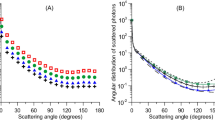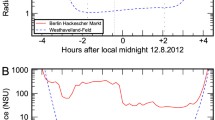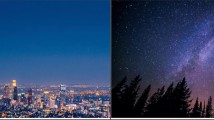Abstract
Light pollution is an issue of global significance for urban ecosystems, especially where areas of natural and ecological importance are located in and around cities. We investigated levels of night sky brightness around Auckland, Aotearoa-New Zealand, to determine the extent of sky glow, its potential to mask the lunar cycle, its relation to land use and the risks it poses to nearby areas of natural and ecological importance. Annual measurements of night sky brightness were carried out over 3 years at 115 randomly chosen sites within 15 km of Auckland’s city centre. In addition, continuous nightly measurements of sky brightness were taken at 6 urban residential sites for 18 months. We found that levels of sky glow in urban Auckland mask the lunar cycle to some extent and modelling suggests that nearby marine and terrestrial areas of ecological importance are at risk. In 2015 and 2016, > 95% of the total expanse of these areas was predicted to be experiencing night skies brighter than natural levels. Increased night sky brightness was associated with proximity to the city centre, commercial and industrial land use, and densities of buildings and streetlights. Reducing sky glow in and around the city should be a management priority, directed at commercial and industrial land-use zones while restricting urban sprawl near areas of natural and ecological importance.




Similar content being viewed by others
Data availability
Data are available upon request.
Code availability
Code is available upon request.
References
Agafonkin V, Thieurmel B (2018) Suncalc: compute sun position, sunlight phases, moon position, and lunar phase. R package version 0.4. https://CRAN.R-project.org/package=suncalc
Auckland Council (2010) Regional parks management plan 2010. https://www.aucklandcouncil.govt.nz/plans-projects-policies-reports-bylaws/our-plans-strategies/topic-based-plans-strategies/parks-sports-outdoor-plans/Documents/regional-parks-management-plan.pdf. Accessed 25 May 2020
Auckland Council (2017) Auckland future urban land supply strategy. https://www.aucklandcouncil.govt.nz/plans-projects-policies-reports-bylaws/our-plans-strategies/topic-based-plans-strategies/housing-plans/Documents/future-urban-land-supply-strategy.pdf. Accessed 25 May 2020
Auckland Council (2018) Auckland unitary plan operative in part. http://unitaryplan.aucklandcouncil.govt.nz/pages/plan/Book.aspx?exhibit=AucklandUnitaryPlan_Print. Accessed 25 May 2020
Ayalon I, Rosenberg Y, Benichou JIC et al (2021) Coral gametogenesis collapse under artificial light pollution. Curr Biol 31:413-419.e3. https://doi.org/10.1016/j.cub.2020.10.039
Bará S (2016) Anthropogenic disruption of the night sky darkness in urban and rural areas. R Soc Open Sci 3:160541. https://doi.org/10.1098/rsos.160541
Barentine JC (2019) Methods for assessment and monitoring of light pollution around ecologically sensitive sites. J Imaging 5:54. https://doi.org/10.3390/jimaging5050054
Bennie J, Davies TW, Cruse D, Bell F, Gaston KJ (2018) Artificial light at night alters grassland vegetation species composition and phenology. J Appl Ecol 55:442–450
Biggs JD, Fouché T, Bilki F, Zadnik MG (2012) Measuring and mapping the night sky brightness of Perth, Western Australia. Mon Not R Astron Soc 421:1450–1464. https://doi.org/10.1111/j.1365-2966.2012.20416.x
Bolton D, Mayer-Pinto M, Clark GF, Dafforn KA, Brassil WA, Becker A, Johnston EL (2017) Coastal urban lighting has ecological consequences for multiple trophic levels under the sea. Sci Total Environ 576:1–9. https://doi.org/10.1016/j.scitotenv.2016.10.037
Bruce-White C, Shardlow M (2011) A review of the impact of artificial light on invertebrates. Buglife, Peterborough
Byrkjedal I, Lislevand T, Vogler S (2012) Do passerine birds utilise artificial light to prolong their diurnal activity during winter at northern latitudes? Ornis Nor 35:37–42
Creed PJ (2007) Stellar extinction model. Retrieved from https://www.skyandtelescope.com/astronomy-resources/transparency-and-atmospheric-extinction/. Accessed 25 May 2020
Da Silva A, Samplonius JM, Schlicht E, Valcu M, Kempenaers B (2014) Artificial night lighting rather than traffic noise affects the daily timing of dawn and dusk singing in common European songbirds. Behav Ecol 25:1037–1047. https://doi.org/10.1093/beheco/aru103
Davies TW, Bennie J, Gaston KJ (2012) Street lighting changes the composition of invertebrate communities. Biol Lett 8:764–767. https://doi.org/10.1098/rsbl.2012.0216
Davies TW, Bennie J, Inger R, Gaston KJ (2013) Artificial light alters natural regimes of night-time sky brightness. Sci Rep 3:1722. https://doi.org/10.1038/srep01722
Dominoni DM, Quetting M, Partecke J (2013) Artificial light at night advances avian reproductive physiology. Proc R Soc B 280:20123017. https://doi.org/10.1098/rspb.2012.3017
Falchi F, Cinzano P, Duriscoe D, Kyba CCM, Elvidge CD, Baugh K, Portnov BA, Rybnikova NA, Furgoni R (2016) The new world atlas of artificial night sky brightness. Sci Adv 2:e1600377. https://doi.org/10.1126/sciadv.1600377
Falchi F, Cinzano P, Elvidge CD, Keith DM, Haim A (2011) Limiting the impact of light pollution on human health, environment and stellar visibility. J Environ Manage 92:2714–2722. https://doi.org/10.1016/j.jenvman.2011.06.029
Garrett JK, Donald PF, Gaston KJ (2020) Skyglow extends into the world’s Key Biodiversity Areas. Anim Conserv 23:153–159. https://doi.org/10.1111/acv.12480
Gaston KJ, Davies TW, Nedelec SL, Holt LA (2017) Impacts of artificial light at night on biological timings. Annu Rev Ecol Evol Syst 48:49–68. https://doi.org/10.1146/annurev-ecolsys-110316-022745
Gauthreaux SA Jr, Belser CG (2006) Effects of artificial night lighting on migrating birds. In: Rich C, Longcore T (eds) Ecological consequences of artificial night lighting. Island Press, Washington DC, pp 67–93
Hale JD, Davies G, Fairbrass AJ, Matthews TJ, Rogers CDF, Sadler JP (2013) Mapping lightscapes: spatial patterning of artificial lighting in an urban landscape. PLoS One 8:e61460
Hänel A, Posch T, Ribas SJ et al (2018) Measuring night sky brightness: methods and challenges. J Quant Spectrosc Radiat Transf 205:278–290. https://doi.org/10.1016/j.jqsrt.2017.09.008
Hölker F, Moss T, Griefahn B et al (2010) The dark side of light: a transdisciplinary research agenda for light pollution policy. Ecol Soc 15:13
Jechow A, Hölker F, Kyba CCM (2019) Using all-sky photometry to investigate how nocturnal clouds darken the night sky in rural areas. Sci Rep 9:1391. https://doi.org/10.1038/s41598-018-37817-8
Jechow A, Kolláth Z, Ribas SJ, Spoelstra H, Hölker F, Kyba CCM (2017) Imaging and mapping the impact of clouds on skyglow with all-sky photometry. Sci Rep 7:6741. https://doi.org/10.1038/s41598-017-06998-z
Knop E, Zoller L, Ryser R, Gerpe C, Hörler M, Fontaine C (2017) Artificial light at night as a new threat to pollination. Nature 548:206–209
Kocifaj M, Lamphar HAS (2014) Quantitative analysis of night skyglow amplification under cloudy conditions. Mon Not R Astron Soc 443:3665–3674. https://doi.org/10.1093/mnras/stu1301
Krisciunas K, Schaefer BE (1991) A model of the brightness of moonlight. Publ Astron Soc Pac 103:1033–1039
Kronfeld-Schor N, Dominoni D, de la Iglesia H, Levy O, Herzog ED, Dayan T, Helfrich-Forster C (2013) Chronobiology by moonlight. Proc R Soc B 280:20123088. https://doi.org/10.1098/rspb.2012.3088
Kuechly HU, Kyba CCM, Ruhtz T, Lindemann C, Wolter C, Fischer J, Hölker F (2012) Aerial survey and spatial analysis of sources of light pollution in Berlin, Germany. Remote Sens Environ 126:39–50. https://doi.org/10.1016/j.rse.2012.08.008
Kupprat F, Hölker F, Kloas W (2020) Can skyglow reduce nocturnal melatonin concentrations in Eurasian perch? Environ Pollut 262:114324. https://doi.org/10.1016/j.envpol.2020.114324
Kyba CCM, Kuester T, Sánchez de Miguel A, Baugh K, Jechow A, Hölker F, Bennie J, Elvidge CD, Gaston KJ, Guanter L (2017) Artificially lit surface of Earth at night increasing in radiance and extent. Sci Adv 3:e1701528. https://doi.org/10.1126/sciadv.1701528
Kyba CCM, Ruhtz T, Fischer J, Hölker F (2011) Cloud coverage acts as an amplifier for ecological light pollution in urban ecosystems. PLoS One 6:e17307. https://doi.org/10.1371/journal.pone.0017307
Kyba CCM, Ruhtz T, Fischer J, Hölker F (2012) Red is the new black: how the colour of urban skyglow varies with cloud cover. Mon Not R Astron Soc 425:701–708. https://doi.org/10.1111/j.1365-2966.2012.21559.x
Kyba CCM, Tong KP, Bennie J et al (2015) Worldwide variations in artificial skyglow. Sci Rep 5:8409. https://doi.org/10.1038/srep08409
Lewanzik D, Voigt CC (2014) Artificial light puts ecosystem services of frugivorous bats at risk. J Appl Ecol 51:388–394. https://doi.org/10.1111/1365-2664.12206
Luginbuhl CB, Boley PA, Davis DR (2014) The impact of light source spectral power distribution on sky glow. J Quant Spectrosc Radiat Transf 139:21–26. https://doi.org/10.1016/j.jqsrt.2013.12.004
Luginbuhl CB, Lockwood GW, Davis DR, Pick K, Selders J (2009) From the ground up I: light pollution sources in Flagstaff, Arizona. Publ Astron Soc Pac 121:185–203
Lyytimäki J, Rinne J (2013) Voices for the darkness: online survey on public perceptions on light pollution as an environmental problem. J Integr Environ Sci 10:127–139. https://doi.org/10.1080/1943815X.2013.824487
Moore MV, Pierce SM, Walsh HM, Kvalik SK, Lim JD (2000) Urban light pollution alters the diel vertical migration of Daphnia. Verh – Int Ver Theor Angew Limnol 27:779–782. https://doi.org/10.1080/03680770.1998.11901341
Pebesma EJ (2004) Multivariable geostatistics in S: the gstat package. Comput Geosci 30:683–691
Pinheiro J, Bates D, DebRoy S, Sarkar D, R Core Team (2018) Nlme: linear and nonlinear mixed effects models. R package version 3.1–131.1. https://CRAN.R-project.org/package=nlme
Posch T, Binder F, Puschnig J (2018) Systematic measurements of the night sky brightness at 26 locations in Eastern Austria. J Quant Spectrosc Radiat Transf 211:144–165. https://doi.org/10.1016/j.jqsrt.2018.03.010
Pun C, So C, Leung W, Wong C (2014) Contributions of artificial lighting sources on light pollution in Hong Kong measured through a night sky brightness monitoring network. J Quant Spectrosc Radiat Transf 139:90–108. https://doi.org/10.1016/j.jqsrt.2013.12.014
Puschnig J, Posch T, Uttenthaler S (2014a) Night sky photometry and spectroscopy performed at the Vienna University observatory. J Quant Spectrosc Radiat Transf 139:64–75. https://doi.org/10.1016/j.jqsrt.2013.08.019
Puschnig J, Schwope A, Posch T, Schwarz R (2014b) The night sky brightness at Potsdam-Babelsberg including overcast and moonlit conditions. J Quant Spectrosc Radiat Transf 139:76–81. https://doi.org/10.1016/j.jqsrt.2013.12.011
Puschnig J, Wallner S, Posch T (2020) Circalunar variations of the night sky brightness – an FFT perspective on the impact of light pollution. Mon Not R Astron Soc 492:2622–2637. https://doi.org/10.1093/mnras/stz3514
R Core Team (2020) R: a language and environment for statistical computing. R Foundation for Statistical Computing, Vienna, Austria. https://www.R-project.org/
Sadler J, Bates A, Hale J, James P (2010) Bringing cities alive: the importance of urban green spaces for people and biodiversity. In: Gaston KJ (ed) Urban ecology. Cambridge University Press, Cambridge, pp 172–201
Sánchez de Miguel A, Aubé M, Zamorano J, Kocifaj M, Roby J, Tapia C (2017) Sky Quality Meter measurements in a colour-changing world. Mon Not R Astron Soc 467:2966–2979. https://doi.org/10.1093/mnras/stx145
Ściężor T, Kubala M, Kaszowski W (2012) Light pollution of the mountain areas in Poland. Arch Environ Prot 38:59–69. https://doi.org/10.2478/v10265-012-0042-4
Stats NZ (2017) Population growth fastest in Northland, Auckland, and Waikato. https://www.stats.govt.nz/news/population-growth-fastest-in-northland-auckland-and-waikato. Accessed 25 May 2020
Torres D, Tidau S, Jenkins S, Davies T (2020) Artificial skyglow disrupts celestial migration at night. Curr Biol 30:PR696–R697. https://doi.org/10.1016/j.cub.2020.05.002
Unihedron (2015) SQM-LE Weatherproof housing. http://unihedron.com/projects/sqmhousing/housing-all.pdf. Accessed 25 May 2020
Waitakere Ranges Heritage Area Act (2008) http://www.legislation.govt.nz/act/local/2008/0001/latest/whole.html#DLM1076035. Accessed 25 May 2020
Zuur AF, Ieno EN, Smith GM (2007) Analysing Ecological Data. Springer, New York
Acknowledgements
We thank the volunteer households involved in the study; and Anna Frances Probert, Carolina Lara Mendoza, Kelly Booth and the McNaughton family for their assistance in the field. This research was supported in part by the University of Auckland and the Centre for Biodiversity and Biosecurity.
Funding
This research was supported in part by the University of Auckland and the Centre for Biodiversity and Biosecurity.
Author information
Authors and Affiliations
Corresponding author
Ethics declarations
Conflicts of interest
The authors declare no competing interest.
Supplementary information
Below is the link to the electronic supplementary material.
Rights and permissions
About this article
Cite this article
McNaughton, E.J., Gaston, K.J., Beggs, J.R. et al. Areas of ecological importance are exposed to risk from urban sky glow: Auckland, Aotearoa-New Zealand as a case study. Urban Ecosyst 25, 273–284 (2022). https://doi.org/10.1007/s11252-021-01149-9
Accepted:
Published:
Issue Date:
DOI: https://doi.org/10.1007/s11252-021-01149-9




